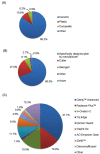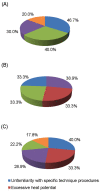Survey on awareness and preference of ceramic bracket debonding techniques among orthodontists
- PMID: 32904974
- PMCID: PMC7462376
- DOI: 10.4317/jced.56976
Survey on awareness and preference of ceramic bracket debonding techniques among orthodontists
Abstract
Background: The objectives of this study was to evaluate the awareness of different ceramic bracket debonding techniques among orthodontists in the USA and the most commonly used debonding technique for ceramic bracket removal.
Material and methods: A survey on preference for debonding and awareness of debonding techniques was emailed to 2,227 members of the American Association of Orthodontists (AAO).
Results: 119 orthodontists completed the survey. 111 responses were included in the study analysis of ceramic bracket users. The most common technique used was mechanical debonding. 86.5% used a specially designed bracket removing plier from the manufacturer. Overall, there were 59.5% of surveyed orthodontists who were aware of electrothermal debonding, 73% were unaware of ultrasonic debonding and 83.8% were unaware of laser debonding. There were more orthodontists with an affiliation with an academic institution aware of electrothermal debonding (p=0.002). There also was a trend of orthodontists having no affiliation with an institution who were unaware of laser debonding (p=0.015).
Conclusions: This survey showed that the majority of orthodontists who responded to the questionnaire were unaware of alternative debonding techniques of ceramic brackets. All orthodontists who use ceramic brackets utilized mechanical debonding technique. Key words:Orthodontic ceramic brackets, mechanical, electrothermal, ultrasonic, laser debonding.
Copyright: © 2020 Medicina Oral S.L.
Conflict of interest statement
Conflicts of interest None declared.
Figures


Similar articles
-
Comparisons of different debonding techniques for ceramic brackets: an in vitro study. Part I. Background and methods.Am J Orthod Dentofacial Orthop. 1990 Aug;98(2):145-53. doi: 10.1016/0889-5406(90)70008-z. Am J Orthod Dentofacial Orthop. 1990. PMID: 2198800
-
Epidemiological survey of different clinical techniques of orthodontic bracket debonding and enamel polishing.J Orthod Sci. 2015 Oct-Dec;4(4):123-7. doi: 10.4103/2278-0203.173425. J Orthod Sci. 2015. PMID: 26952141 Free PMC article.
-
Efficacy of Lasers in Debonding Ceramic Brackets: Exploring the Rationale and Methods.Cureus. 2024 May 25;16(5):e61050. doi: 10.7759/cureus.61050. eCollection 2024 May. Cureus. 2024. PMID: 38915986 Free PMC article. Review.
-
Er:YAG Laser for Metal and Ceramic Bracket Debonding: An In Vitro Study on Intrapulpal Temperature, SEM, and EDS Analysis.Photomed Laser Surg. 2018 Nov;36(11):595-600. doi: 10.1089/pho.2017.4412. Epub 2018 Jun 15. Photomed Laser Surg. 2018. PMID: 29905504
-
Laser-Aided Ceramic Bracket Debonding: A Comprehensive Review.J Lasers Med Sci. 2016 Winter;7(1):2-11. doi: 10.15171/jlms.2016.02. Epub 2016 Jan 7. J Lasers Med Sci. 2016. PMID: 27330690 Free PMC article. Review.
Cited by
-
Orthodontic Bracket Removal Using LASER-Technology-A Short Systematic Literature Review of the Past 30 Years.Materials (Basel). 2022 Jan 12;15(2):548. doi: 10.3390/ma15020548. Materials (Basel). 2022. PMID: 35057264 Free PMC article. Review.
References
-
- Bishara SE, Fehr DE. Ceramic brackets: something old, something new, a review. Seminars in orthodontics. 1997;3:178–88. - PubMed
-
- Feldner JC, Sarkar NK, Sheridan JJ, Lancaster DM. In vitro torque-deformation characteristics of orthodontic polycarbonate brackets. Am J Orthod Dentofacial Orthop. 1994;106:265–72. - PubMed
-
- Choudhary G, Gill V, Reddy YNN, Sanadhya S, Aapaliya P, Sharma N. Comparison of the Debonding Characteristics of Conventional and New Debonding Instrument used for Ceramic, Composite and Metallic Brackets - An Invitro Study. Journal of Clinical and Diagnostic Research : JCDR. 2014;8:ZC53–ZC5. - PMC - PubMed
-
- Karamouzos A, Athanasiou AE, Papadopoulos MA. Clinical characteristics and properties of ceramic brackets: A comprehensive review. Am J Orthod Dentofacial Orthop. 1997;112:34–40. - PubMed
-
- Flores DA, Caruso JM, Scott GE, Jeiroudi MT. The fracture strength of ceramic brackets: a comparative study. The Angle orthodontist. 1990;60:269–76. - PubMed
LinkOut - more resources
Full Text Sources
